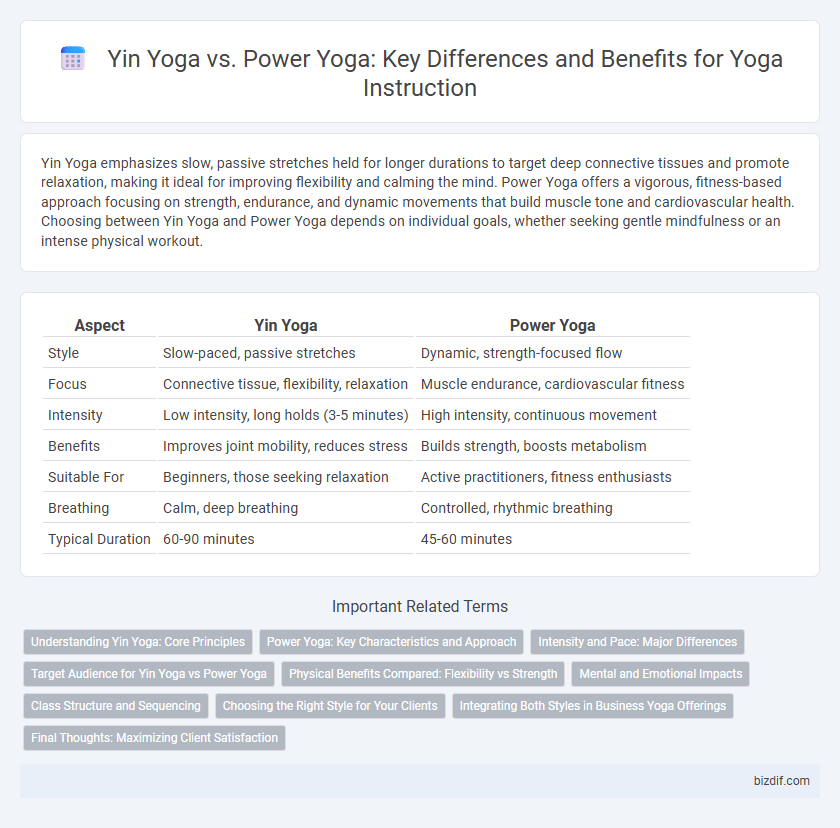Yin Yoga emphasizes slow, passive stretches held for longer durations to target deep connective tissues and promote relaxation, making it ideal for improving flexibility and calming the mind. Power Yoga offers a vigorous, fitness-based approach focusing on strength, endurance, and dynamic movements that build muscle tone and cardiovascular health. Choosing between Yin Yoga and Power Yoga depends on individual goals, whether seeking gentle mindfulness or an intense physical workout.
Table of Comparison
| Aspect | Yin Yoga | Power Yoga |
|---|---|---|
| Style | Slow-paced, passive stretches | Dynamic, strength-focused flow |
| Focus | Connective tissue, flexibility, relaxation | Muscle endurance, cardiovascular fitness |
| Intensity | Low intensity, long holds (3-5 minutes) | High intensity, continuous movement |
| Benefits | Improves joint mobility, reduces stress | Builds strength, boosts metabolism |
| Suitable For | Beginners, those seeking relaxation | Active practitioners, fitness enthusiasts |
| Breathing | Calm, deep breathing | Controlled, rhythmic breathing |
| Typical Duration | 60-90 minutes | 45-60 minutes |
Understanding Yin Yoga: Core Principles
Yin Yoga emphasizes long-held, passive poses targeting deep connective tissues and fascia to enhance joint flexibility and promote meditative awareness. This practice prioritizes stillness and breath control, fostering mental calmness and physical relaxation through sustained, gentle stretches. Unlike the dynamic, strength-building sequences of Power Yoga, Yin Yoga cultivates balance by encouraging introspection and deep tissue release.
Power Yoga: Key Characteristics and Approach
Power Yoga emphasizes strength, flexibility, and endurance through dynamic, fast-paced sequences inspired by traditional Ashtanga yoga. It focuses on building muscle tone and cardiovascular fitness by linking breath with continuous movement, offering a vigorous, high-energy workout. This style is ideal for practitioners seeking an intense, physically challenging practice that also enhances mental focus and stamina.
Intensity and Pace: Major Differences
Yin Yoga emphasizes slow-paced, passive holds that target deep connective tissues and promote relaxation, making it low-intensity and meditative. Power Yoga features dynamic, fast-paced sequences focusing on strength, flexibility, and cardiovascular endurance, resulting in high-intensity workouts. These contrasting intensity and pace profiles cater to practitioners seeking either restorative, slow movements or vigorous, energetic practice.
Target Audience for Yin Yoga vs Power Yoga
Yin Yoga primarily targets individuals seeking deep relaxation, improved joint mobility, and enhanced flexibility through slow, passive poses held for extended periods, making it ideal for beginners, seniors, and those recovering from injury. Power Yoga attracts fitness enthusiasts and experienced practitioners looking for a vigorous, strength-building practice that enhances cardiovascular endurance, muscle tone, and dynamic flexibility. Understanding these distinct target audiences helps instructors tailor classes to meet specific physical and mental wellness goals.
Physical Benefits Compared: Flexibility vs Strength
Yin Yoga enhances deep flexibility by targeting connective tissues and promoting joint mobility through long-held passive poses, making it ideal for improving range of motion and preventing injury. Power Yoga builds muscular strength and endurance by incorporating dynamic, weight-bearing movements and is effective for toning muscles and boosting cardiovascular fitness. Both styles complement each other by balancing flexibility development in Yin Yoga with strength gains in Power Yoga, supporting holistic physical health.
Mental and Emotional Impacts
Yin Yoga promotes deep relaxation and mindfulness by targeting connective tissues and encouraging longer holds, reducing stress and fostering emotional balance. Power Yoga stimulates the nervous system through dynamic, strength-building sequences, enhancing mental focus and energizing mood. Both styles offer distinct benefits for mental and emotional well-being, with Yin Yoga calming anxiety and Power Yoga boosting confidence and resilience.
Class Structure and Sequencing
Yin Yoga classes emphasize long-held passive poses targeting deep connective tissues, typically lasting 60 to 90 minutes with a slow, meditative pace designed for relaxation and flexibility. Power Yoga sessions feature dynamic sequences incorporating strength-building, cardiovascular elements, and faster transitions, usually structured as 45 to 60-minute high-intensity workouts. Sequencing in Yin Yoga prioritizes passive stretches for joint health, while Power Yoga follows vinyasa flows integrating core engagement and muscle endurance.
Choosing the Right Style for Your Clients
Yin Yoga emphasizes deep stretching and relaxation through long-held poses, ideal for clients seeking increased flexibility and stress relief, while Power Yoga provides a dynamic, strength-building practice suited for those aiming to improve cardiovascular fitness and muscle tone. Assessing client goals, physical limitations, and energy levels ensures the selection of a Yoga style that maximizes benefits and maintains engagement. Instructors can create personalized sessions by combining elements of both Yin and Power Yoga based on individual needs and preferences.
Integrating Both Styles in Business Yoga Offerings
Integrating Yin Yoga and Power Yoga in business yoga offerings enhances client engagement by balancing slow, deep stretch techniques with dynamic, strength-building sequences, catering to diverse fitness levels and wellness goals. Yin Yoga promotes relaxation and joint mobility, while Power Yoga increases cardiovascular endurance and muscular strength, creating a comprehensive wellness program. Offering both styles attracts a broader clientele, improves retention rates, and positions businesses as versatile providers of holistic yoga solutions.
Final Thoughts: Maximizing Client Satisfaction
Yin Yoga emphasizes deep stretching and relaxation, promoting joint health and mental calmness, which appeals to clients seeking restorative practices. Power Yoga offers a dynamic, strength-building workout that enhances cardiovascular fitness and muscular endurance, attracting those aiming for vigorous exercise. Tailoring sessions by balancing Yin Yoga's slow, meditative poses with Power Yoga's energetic flows maximizes client satisfaction through personalized wellness goals.
Yin Yoga vs Power Yoga Infographic

 bizdif.com
bizdif.com